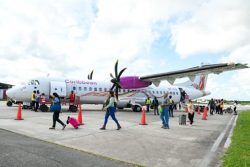The incident involving the Trans Guyana Airways (TGA) plane at the Kurupung airstrip in May was not a “hard landing” but a “short landing,” Minister of Public Works Robeson Benn says.
“In this particular instance it was not a “hard landing” but a “short landing” by the pilot of the aircraft,” Benn said in a written response to a question posed by APNU parliamentarian Dr. Karen Cummings in the National Assembly recently. According to Benn, the contributory factors were wind shear and downdraught.
At the time, in a statement on the May 16 incident, the Guyana Civil Aviation Authority (GCAA) had said that the aircraft had hard-landed during its approach at the Region Seven airstrip. The GCAA had said in a statement that a hard landing is an especially rapid or steep descent. There were no injuries. GCAA Director-General Zulficar Mohamed was quoted as saying that the aircraft landed on the airstrip’s threshold, resulting in damage to the left landing gear.
Subsequently, TGA spokesman Kit Nascimento told Stabroek News that the `hard landing’ was a consequence of the lack of the 100-foot approach to the strip and an equal distance at the other end of it. He had lamented that the aircraft owners association had been pressing the aviation authorities for years to take the required steps to ensure that Kurupung and several other airstrips had the requisite approach space to cater for events like a downdraft.
The GCAA statement had said that the incident occurred at approximately 12:27pm but Benn told the National Assembly that the incident occurred at 1:57pm. “The aircraft which was seriously damaged, landed before the threshold, the left landing gear moved rearward 39 inches tearing the nacelle (a streamlined enclosure (as for an engine) on an aircraft). There were wrinkles to both surfaces of the wing and flaps,” Benn said.
He added that in order to minimize the event of any “hard landing” of a commercial plane, training and experience must be the main focus by the relevant companies. The training consists of airman proficiency checks every six months by the relevant companies and route and aerodrome checks once every 12 months in accordance with GCAA requirements, he said.
In response to other questions, Benn said that for last year, satisfactory maintenance was carried out to the Kurupung airstrip for the sum of $640 000. There is a resident contractor who has responsibility for maintenance of this airstrip all year round and this is the case with all other government airstrips, he said. He added that these airstrips are examined periodically jointly by the aviation inspectors in the Ministry and GCAA.
Benn had noted that the Kurupung Airstrip is 1365 feet long and 43 feet wide. “It is bordered on the eastern end by a deep valley and a swamp with a creek on the western end, hence there is very little scope to facilitate its lengthening,” he said.





